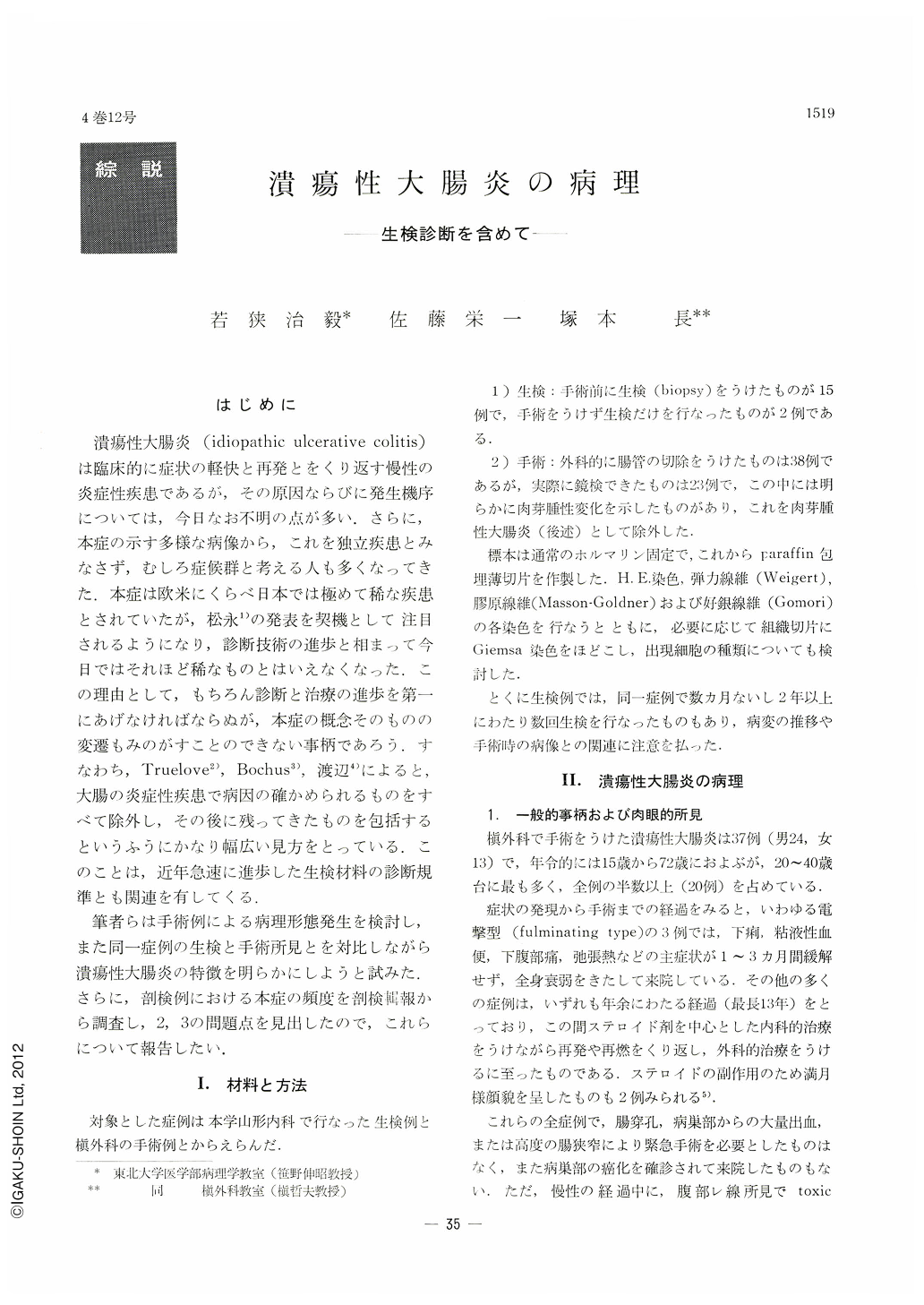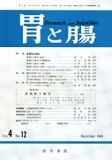Japanese
English
- 有料閲覧
- Abstract 文献概要
- 1ページ目 Look Inside
はじめに
潰瘍性大腸炎(idiopathic ulcerative colitis)は臨床的に症状の軽快と再発とをくり返す慢性の炎症性疾患であるが,その原因ならびに発生機序については,今日なお不明の点が多い.さらに,本症の示す多様な病像から,これを独立疾患とみなさず,むしろ症候群と考える人も多くなってきた.本症は欧米にくらべ日本では極めて稀な疾患とされていたが,松永1)の発表を契機として注目されるようになり,診断技術の進歩と相まって今日ではそれほど稀なものとはいえなくなった.この理由として,もちろん診断と治療の進歩を第一にあげなければならぬが,本症の概念そのものの変遷もみのがすことのできない事柄であろう.すなわち,Truelove2),Bochus3),渡辺4)によると,大腸の炎症性疾患で病因の確かめられるものをすべて除外し,その後に残ってきたものを包括するというふうにかなり幅広い見方をとっている.このことは,近年急速に進歩した生検材料の診断規準とも関連を有してくる.
筆者らは手術例による病理形態発生を検討し,また同一症例の生検と手術所見とを対比しながら潰瘍性大腸炎の特徴を明らかにしようと試みた.さらに,剖検例における本症の頻度を剖検輯報から調査し,2,3の問題点を見出したので,これらについて報告したい.
Idiopathic ulcerative colitis is a chronic disease with a clinical manifestation of a severe active phase and a remitting or relapsing period during its course. The features of the disease are so variable that many authors regard it as a syndrome rather than a disease entity. Although, in the past, it was a rather rare disease, there has been an increasing number of reports of cases manifesting clinical and pathological features since Matsunaga's detailed report in Japan. It is partly due to a remarkable progress of clinical diagnostic procedures, but mostly due to a conceptual change concerning the disease.
In this report, it is attempted to describe pathologic features of ulcerative colitis by using biopsy specimens and surgical materials, with special attention to correlation between biopsy and surgical picture of the same cases. The authors also pointed out some confusion of terminology on ulcerative colitis in autopsy cases collected from “Annual Report for Autopsies in Japan” for the past 5 years period.
The histopathologic features are summarized as follows;
1) Irregular arrangement of the intestinal gland and disappearance of its basal membrane.
2) Severe infiltrate of the inflammatory cells, forming a granulation tissue.
3) An appearance of cryptabscess and the formation of ulceration.
4) Edematous change and final scar formation in the submucosa.
5) Regenerating phenomenon in the mucosa.
Among these findings, cryptabscess is considered to be the most characteristic feature for the formation of ulceration and this is also very much helpful for the diagnostic value of colon biopsy. The remaining mucosa unimpaired by ulceration makes mucosal bridge or shows a proliferation of pseudopolyps, comprising gross features of surgical materials.
The inflammatory cells are mainly composed of plasma cells, neutrophils, eosinophils, histiocytes, and a few mast cells. In several cases, an enlargement and or a hyperplasia of lymphatic tissue in the intestinal wall are quite characteristic. They usually contain a number of large mononuclear cells with vesicular nucleus and prominent nucleolus. In a few cases, examinations of enlarged regional lymph nodes near the involved inestinal wall have revealed that numerous large cells similar to those in lymphatic tissue were proliferated particularly in medullary cord. These cells have a similarity to those found in lymph nodes with an affection of virus. An observation that a quite large nucleus like cytomegalic inclusion was revealed in the epithelium of intestinal gland also suggests this.
There are 57 autopsies termed as ulcerative colitis in “Annual Report for Autopsies” for the past 5 years. Among them, 41 cases have severe basic diseases, such as malignant tumor, uremia, infection etc. and they are regarded to have colitis accompanied with lethal diseases. Excluding them, the remained 16 cases should be diagnosed as idiopathic ulcerative colitis from a point of narrow sense. Such a fact suggests that there would be a confusion on terminology by pathologists in Japan.
A further study searching for etiology, which might not be simple, is necessary.

Copyright © 1969, Igaku-Shoin Ltd. All rights reserved.


